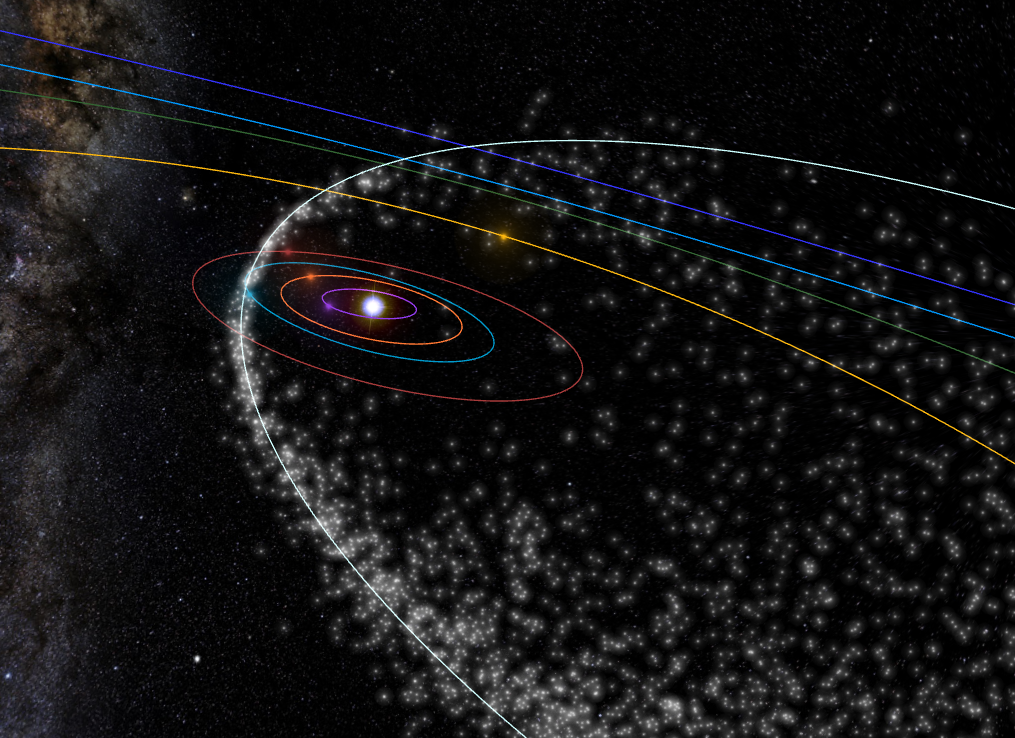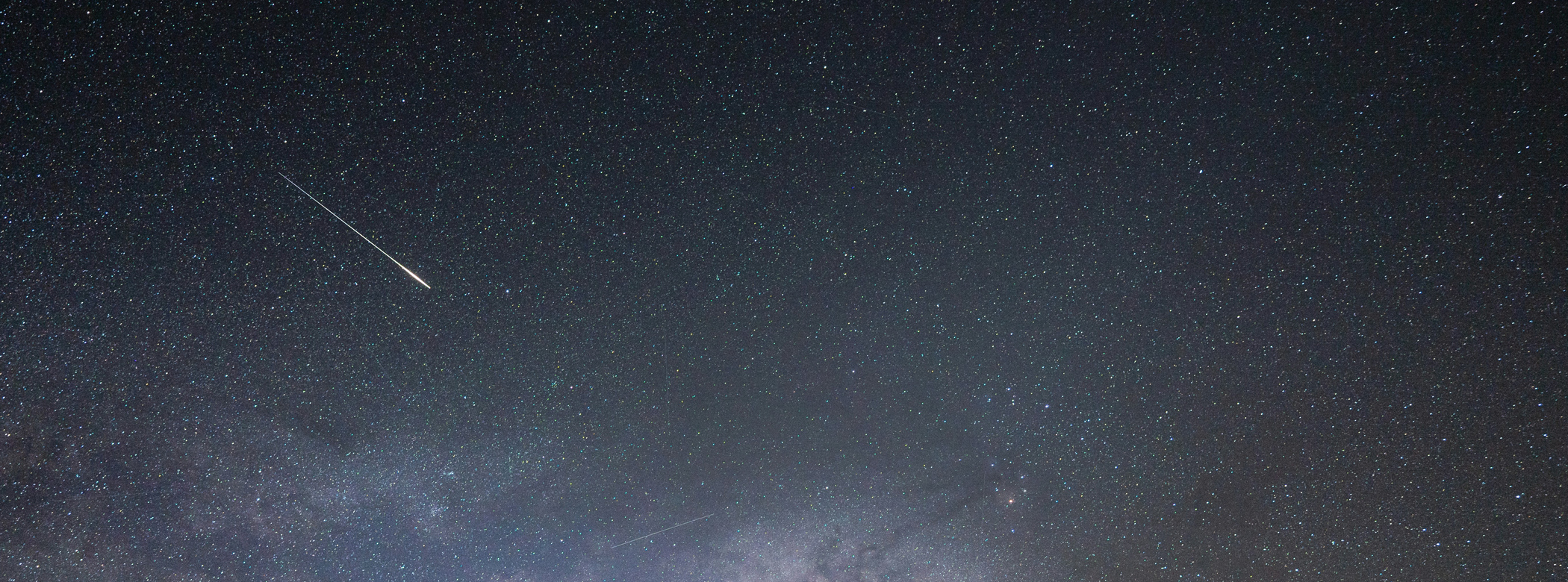Meteors
A meteor (a.k.a. falling star, shooting star) looks like a bright streak across the starry sky that lasts for a second or two before fading away. Most people believe they are rare enough that you should make a wish when you see one, but they are surprisingly common if you watch the sky a lot. On any given night with no Moon, if you get away from city lights and watch the sky continuously, you’ll see up to a half-dozen meteors per hour. Any light sources – the Moon, city lights, you phone – will reduce that number to near zero.
Each meteor you see is actually a tiny piece of dust about the size of a grain of sand which is burning up in the Earth’s atmosphere. Space isn’t empty, you see – it’s dusty, with all the dust leftover from the big construction job that was the formation of the solar system. As the Earth orbit the Sun, it plows through the dust at over 100,000 kilometers per hour. It’s a one-sided collision, and the poor speck of dust disintegrates in a flash of light that we can see from the ground as a meteor.

Meteor Showers
So far, so good – you can see these little specks of dust as they vaporize, and they pretty much occur randomly all the time, we just don’t usually notice. But, it turns out that space isn’t evenly dusty. There are spots, just like in your house, that have more dust than others. In my house, these dust bunnies congregate under the furniture and anyplace the air vents push them; in the solar system these dust bunnies remain where they were shed, in the orbital paths of comets. The solar system is crisscrossed by trails of dust left behind by various comets (and a few asteroids). If the Earth’s orbit intersects one of those trails, we will fly through an interplanetary dust bunny every year around the same time. That’s a meteor shower.
The name “meteor shower” makes you think you can see a lot more meteors than on other nights. But here’s the thing: “a lot” can mean different things. Forty times the normal rate sounds like a lot, until you remember it’s forty times about one meteor per hour. There are over a hundred meteor showers catalogued, but there are only a couple of meteor showers a year that produce more than forty meteors an hour. Even during an official meteor “shower”, you can probably only expect to see a half-dozen meteors per hour, and that’s under perfect skies with your eyes watching the sky 100% of the time.
The Perseids for 2024
So, most meteor showers don’t produce many meteors; that’s the bad news. The good news is, the Perseids in August is one of them, which makes them probably the most famous meteor shower of all. And, in 2024 the Moon will be out of the sky during the crucial morning hours. If you can get away from city lights under a clear, dark sky, you might see up to 60 meteors an hour – one a minute – in the early morning hours of August 12.
That’s pretty specific timing, but luckily the Perseids “dust bunny” is more than one day wide. The Earth actually enters the outer edge of it in late July, and each morning the rates will increase until the peak on the 11th-12th. So, we have several chances to see a decent Perseids display this year.
The key point to remember is that all meteor showers are best between about 1:30 a.m. and 5 a.m. local time. Pre-midnight observing might be 1/10 or less of the morning rates. Really, you have to stay up all night to see this.
To get the best view, get as far away from city lights as practical, and set up a reclining lawn chair or blanket so you can lean back and see as much of the sky as possible. Keep all the lights around you off, especially if you are in a park of other spot with other observers. One peek at your phone will shut off the natural night vision of your eyes for up to ten minutes, so you really need to avoid looking at any lights. (If you need to keep your car running, cover the headlights with a blanket or something so you don’t blast the whole park with your lights!) If you have any lights nearby, put them behind you out of your view, and just watch the sky. You don’t need a telescope or binoculars – in fact, those instruments restrict your field of view so much that you probably won’t see any meteors through them at all. The meteors can appear anywhere in the sky, and they only last a second or two – literally, don’t blink or you can miss them.
Meteors and Cameras
You can take pictures of meteors, but it involves a little luck, and some understanding of your camera. If you have a DSLR or mirrorless camera, you can put it on a tripod and set your exposure manually for something like 5 or 10 seconds – you’ll get a lot of pictures of stars, but if you’re lucky a meteor will happen while you’re shooting, and it will show up in one picture.
If you’re using your phone camera, you might need to download a better camera app than the one your phone came with – check out the app store for one that is designed for night or sky photography. The same tactic applies – take lots of pictures, and hope you catch one. Make sure the light from your camera doesn’t interfere with your vision, though – just take the pictures now, and look at them later.
One thing to watch for: satellites. There are piles of satellites that will show up in your images as streaks of light. You can tell satellites by the trail being the same brightness and thickness throughout; meteors tend to start faint and narrow, get brighter and wider, and then trail out again.
Other Summer Meteor Showers
While technically there are other meteor showers in July and August, in practice these are not noticeable to the average observer and are scientific designations only. They’re named after the constellation or star that the meteors appear to radiate from, but most of them produce a meteor every couple of hours or so – not even a spritzing, let alone a shower. Even the bigger South Delta Aquariid meteor shower, which peaks in late July, only produces about 5 meteors an hour at best. If you are interested in these minor meteor showers, there is backyard science that can be done by tracking them with a camera, though; visit the International Meteor Organization for some great information on getting deeper into the science of meteor observing.
tl;dr: The morning of August 12th between 1:30 a.m. and 4:30 a.m. you will probably see quite a few meteors. The morning before and after, you’ll still see a good number. The rest of the summer, you’ll hardly see any, but you might see one anytime you are looking at the stars.



